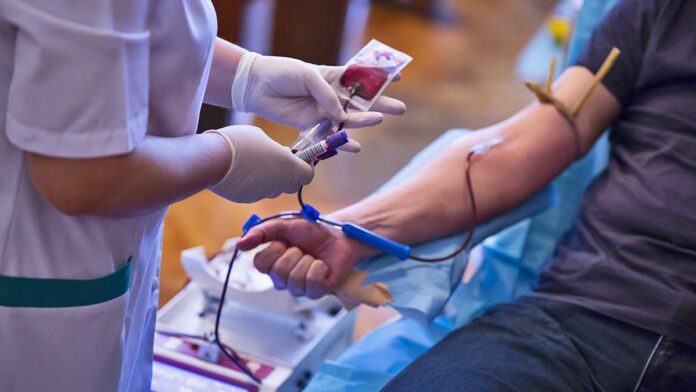On Aug. 7, the Red Cross implemented the Food and Drug Administration’s (FDA) final guidelines for prospective blood donors, which eliminated long-time restrictions that required men who have sex with men (MSM) to abstain from sex for certain time periods before donating. Instead, the recommendations say that all people who wish to donate blood, regardless of sexual orientation or gender, should answer a series of questions to assess their individual risk of HIV.
“The new rules definitely feel less discriminatory to those of us in the LGBTQ+ community,” Kareem Mims, prevention health care coordinator at Prevention Point Philadelphia, said in an email. Prevention Point is a nonprofit health organization that provides harm reduction services. “While the new guidelines are long overdue and a step in the right direction, I believe there is still room for improvement.”
Stipulations in the FDA guidelines remain in place, which say that prospective donors who have had a new sexual partner, multiple sexual partners or who have had anal sex in the past three months will be deferred to lower the risk of donations from people who have new HIV infections. Plus, people who are taking medication to prevent or treat HIV, including antiretroviral therapy drugs, PrEP and PEP, will also be deferred because the use of those meds makes it difficult to detect HIV via screening tests for blood donations.
“I understand the FDA needs to screen people efficiently, but a more detailed set of questions and guidelines could allow more people to participate and donate blood,” Mims said. “By excluding people who have had any anal sex or a new sexual partner in the previous three months, this unnecessarily eliminates people who might be good candidates for donating.
“Someone in a monogamous relationship who has anal intercourse is at very low risk of acquiring HIV, but is excluded by these guidelines. People who are actively and consistently taking PrEP are taking extra precautions, taking care of their health, and are actively being tested frequently to look for HIV infection. These individuals have a very low risk of HIV infection, and it is surprising that they would still be excluded.”
Most blood banks will enforce the new recommendations, The Philadelphia Inquirer reported, but the guidelines are not compulsory, so some blood donation centers may not incorporate them right away. As of Aug. 7, those who wish to donate blood can do so using the latest guidelines at the Jefferson Health and Philadelphia Red Cross blood donation centers, according to The Inquirer.
“With the current guidelines, Prevention Point participants would virtually all be excluded from donating blood,” Mims added.
In 2020, the FDA revised its guidelines for blood donations from MSM, having reduced the deferral period from one year of abstinence to three months. Prior to that, the FDA outright banned MSM from donating blood from the beginning of the HIV/AIDS epidemic in 1985 all the way until 2015.
“I think [the new guidelines are] a better thing,” said Javontae Williams, prevention program manager at the Division of HIV Health in the Philadelphia Department of Public Health (PDPH). “Public health is constantly evolving, and trying to be more equitable and take into account a whole-person approach. I think that we’re moving to an understanding of healthcare at the individual level, rather than stigmatizing entire groups of people.”
Williams emphasized the need to eliminate stigma related to HIV when it comes to introducing public health measures.
“Ultimately, when we say that certain populations have a waiting period based on risk behaviors, whether that be at the population level or at the individual level, we are reinforcing stigma about HIV, even if it’s unintentionally,” Williams added.
In his job at the health department, Williams said he encounters people who are unaware that the HIV epidemic still persists, and that the disease very much still impacts some populations. The 2021 HIV Surveillance Report published by the Philadelphia Department of Public Health, indicates that 18,351 people are living with diagnosed HIV in Philadelphia in cases reported through June 2022.
“I remember when we were talking about ending the HIV epidemic locally a few years ago and ongoing, that people did not know that Philadelphia had an HIV epidemic,” Williams said. “They didn’t know that we were still in the midst of a global health crisis. I like to make the comparison: imagine if COVID lasted 40, 45 years — how the world would look. It’s not sustainable. But here we are 40+ years after the onset of HIV/AIDS, and we’re still pretty much in a crisis environment among certain populations.”
When the PDPH was navigating mpox in the summer of 2022, they found that high rates of people who had prominent symptoms of mpox were also living with HIV. Health department officials don’t yet have a full understanding of the connection between the two diseases. Ultimately, Williams believes that the more frequently HIV comes up in public health discourse, the more it will lessen stigma around the virus.
“There may be a heterosexual white woman in the suburbs who doesn’t know that HIV is still a thing to affect her, until it comes to a conversation about blood donation,” Williams explained. “So I think these conversations are very important.”

